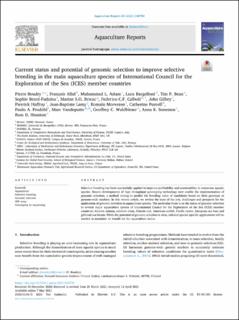Current status and potential of genomic selection to improve selective breeding in the main aquaculture species of International Council for the Exploration of the Sea (ICES) member countries
Boudry, Pierre; Allal, François; Aslam, Muhammad Luqman; Bargelloni, Luca; Bean, Tim P.; Brard-Fudulea, Sophie; Brieuc, Marine Servane Ono; Calboli, Federico C. F.; Gilbey, John; Haffray, Pierrick; Lamy, Jean-Baptiste; Morvezen, Romain; Purcell, Catherine; Prodöhl, Paulo; Vandeputte, Marc; Waldbieser, Geoffrey C.; Sonesson, Anna Kristina; Houston, Ross D.
Peer reviewed, Journal article
Published version
Permanent lenke
https://hdl.handle.net/11250/2978985Utgivelsesdato
2021Metadata
Vis full innførselSamlinger
- Artikler / Articles [1456]
- Publikasjoner fra CRIStin [2533]
Sammendrag
Selective breeding has been successfully applied to improve profitability and sustainability in numerous aquatic species. Recent developments of high throughput genotyping technology now enable the implementation of genomic selection, a method aiming to predict the breeding value of candidates based on their genotype at genome-wide markers. In this review article, we review the state of the arts, challenges and prospects for the application of genomic selection in aquaculture species. The particular focus is on the status of genomic selection in several major aquaculture species of International Council for the Exploration of the Sea (ICES) member countries: Atlantic salmon, rainbow trout, Atlantic cod, American catfish, Pacific oyster, European sea bass and gilthead sea bream. While the potential of genomic selection is clear, tailored species-specific applications will be needed to maximise its benefit for the aquaculture sector.
